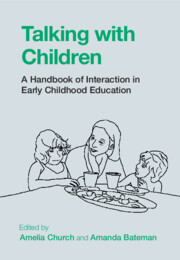Book contents
- Talking with Children
- Talking with Children
- Copyright page
- Dedication
- Contents
- Figures
- Tables
- Contributors
- Acknowledgements
- Notes on Transcription Conventions
- Introduction
- Part I Talk as Social Action
- Part II Pedagogy in Interaction
- 8 Literacy
- 9 Storytelling
- 10 Digital Technologies
- 11 Mathematics
- 12 Creativity
- 13 Multilingualism
- 14 Belonging
- Part III Interaction and Inclusion
- Index
- References
14 - Belonging
from Part II - Pedagogy in Interaction
Published online by Cambridge University Press: 16 June 2022
- Talking with Children
- Talking with Children
- Copyright page
- Dedication
- Contents
- Figures
- Tables
- Contributors
- Acknowledgements
- Notes on Transcription Conventions
- Introduction
- Part I Talk as Social Action
- Part II Pedagogy in Interaction
- 8 Literacy
- 9 Storytelling
- 10 Digital Technologies
- 11 Mathematics
- 12 Creativity
- 13 Multilingualism
- 14 Belonging
- Part III Interaction and Inclusion
- Index
- References
Summary
In this chapter, we review some of the most commonly invoked educational challenges of working with children who are bilingual or multilingual and point to their moorings in a normative, strictly monolingual perspective – a monolingual bias. We then move on to present an alternative, and radically social, understanding of childhood multilingualism firmly based in the growing body of CA-oriented studies of bi- and multilingual interaction in early childhood education settings. Drawing on data from different educational contexts, we examine the manifold ways that participants make use of language alternation, showing how the availability of more than one language can be used productively, as a resource that supports learning. We round off the chapter by highlighting some implications for educators who work with multilingual children. Although the extracts provided in the text are taken from settings where both teacher and children share more than one language, the affordances we discuss will be of relevance to educators who do not have access to children’s first language.
Keywords
- Type
- Chapter
- Information
- Talking with ChildrenA Handbook of Interaction in Early Childhood Education, pp. 286 - 306Publisher: Cambridge University PressPrint publication year: 2022
References
- 1
- Cited by



